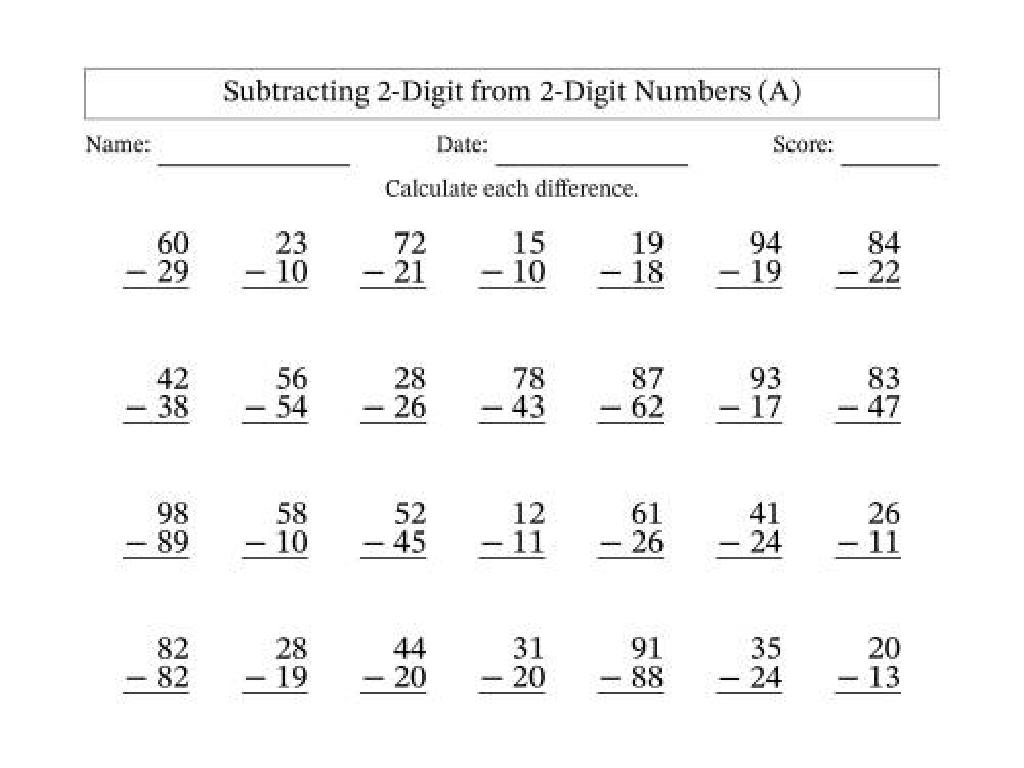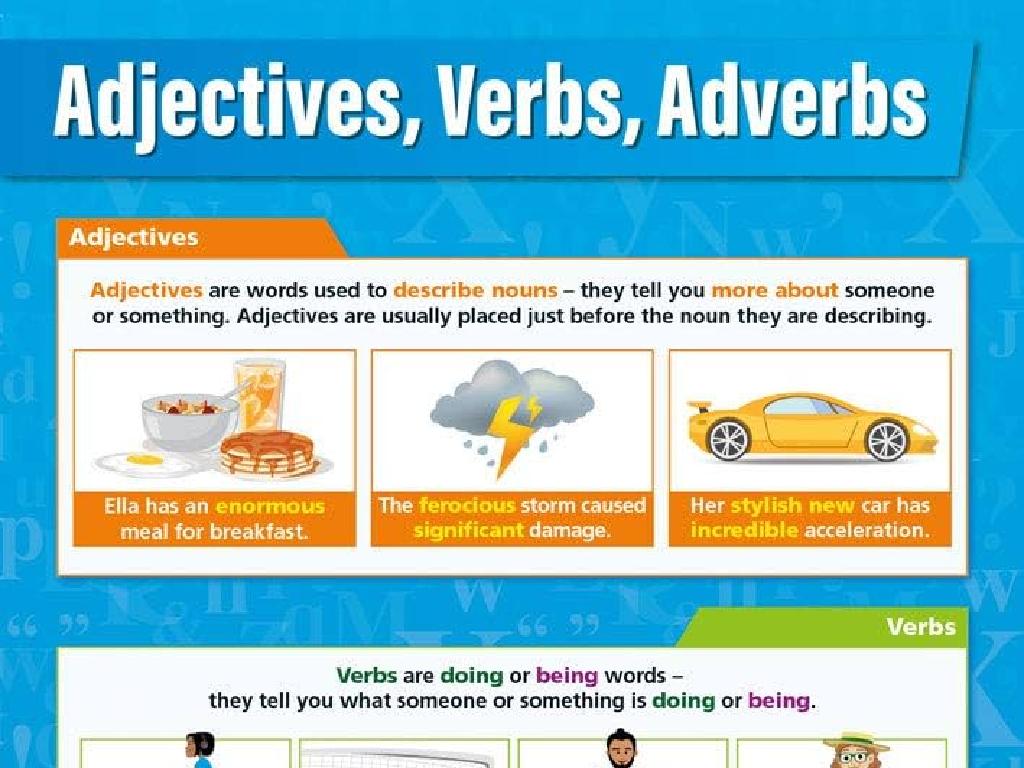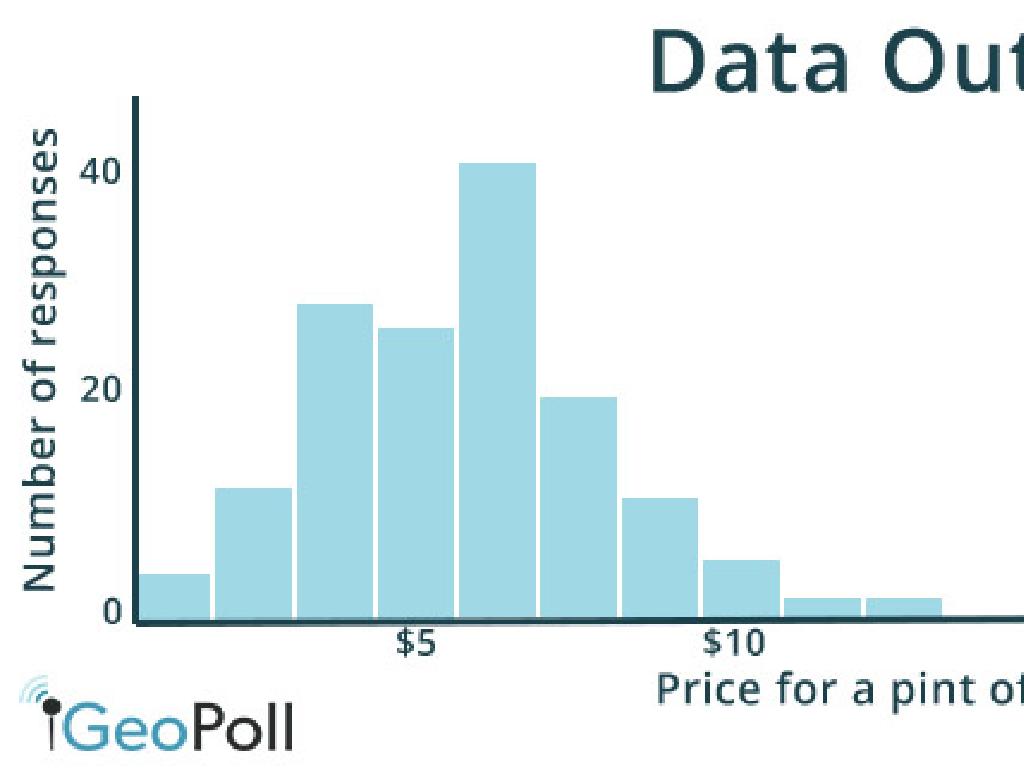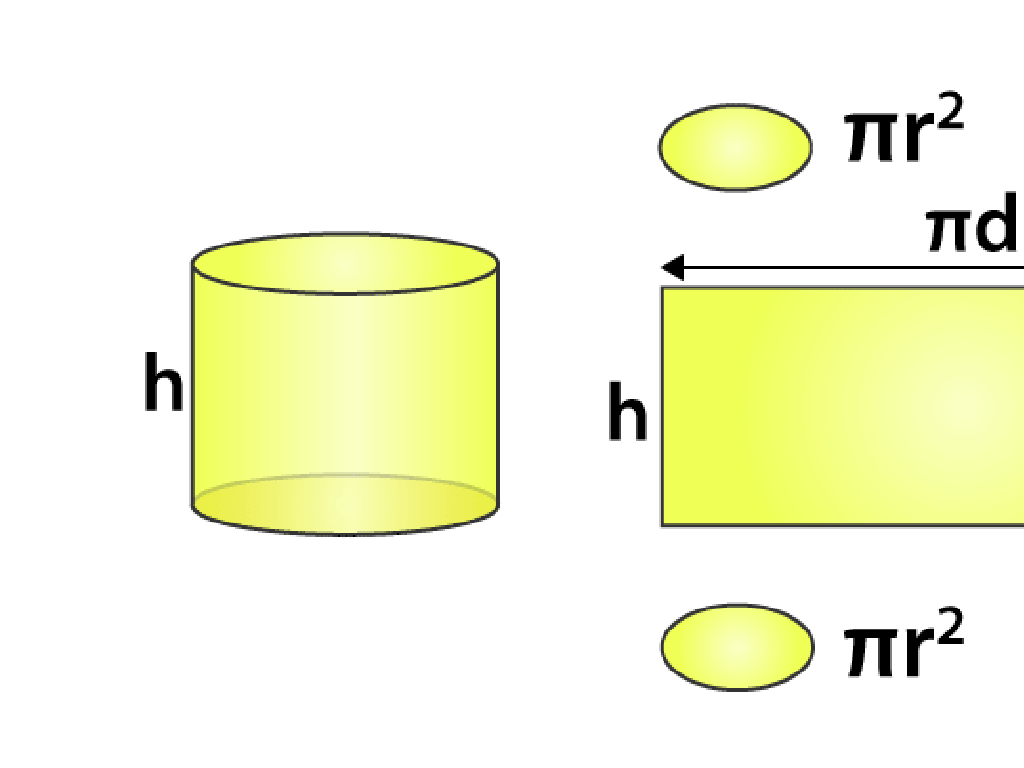Compare Fractions And Mixed Numbers
Subject: Math
Grade: Fifth grade
Topic: Compare Fractions
Please LOG IN to download the presentation. Access is available to registered users only.
View More Content
Comparing Fractions and Mixed Numbers
– What are fractions?
– Fractions represent parts of a whole
– Like a pizza sliced into pieces
– Comparing fractions in daily life
– Which is more? 1/2 pizza or 1/4 pizza
– Why is it important?
– Helps in making fair decisions and understanding portions
|
Begin the lesson by explaining the concept of fractions as parts of a whole, using tangible examples like slices of pizza to illustrate the idea. Emphasize that fractions are everywhere in our daily lives, from measuring ingredients in cooking to dividing up time for activities. Highlight the importance of comparing fractions by presenting real-life scenarios where students might need to determine which fraction is larger or smaller to make fair and informed decisions. Encourage students to think of other examples where they compare parts of a whole, such as sharing snacks or dividing up chores. This will help them understand the relevance of fractions and mixed numbers beyond the classroom.
Understanding Fractions
– Definition of a fraction
– A fraction represents a part of a whole.
– Numerator vs. denominator
– Top number (numerator) and bottom number (denominator).
– Fractions in daily life
– Pizza slices, sharing candy, measuring cups.
– Practice with real examples
– Let’s look at fractions we use every day!
|
Begin by explaining that a fraction is a way to represent a part of a whole, using two numbers separated by a line. The top number, or numerator, indicates how many parts we have, while the bottom number, or denominator, shows how many equal parts the whole is divided into. Use relatable examples like slices of pizza to illustrate fractions in a way that is tangible for fifth graders. For instance, if a pizza is cut into 8 slices and you eat 3, you’ve eaten 3/8 of the pizza. Encourage students to think of other examples where they encounter fractions in their daily lives, such as when they share snacks or use measuring cups for cooking. This will help them understand the concept of fractions and how they are used outside of the classroom.
Understanding Mixed Numbers
– Define a mixed number
– A number made up of a whole number and a fraction, like 2 1/2
– Mixed numbers: whole & fraction
– Imagine a pizza with 2 whole pieces and a half piece left
– Real-world mixed number examples
– Examples: 1 3/4 hours of play, 5 1/2 feet tall
– Practice with mixed numbers
|
This slide introduces the concept of mixed numbers, which are used to represent a value that combines a whole number with a fraction. Start by defining a mixed number and then explain how it is composed of a whole number and a fraction part. Use relatable examples such as time spent playing or a person’s height to illustrate mixed numbers in a context familiar to fifth graders. Encourage students to think of other examples from their daily lives. Conclude with practice problems where students identify and create mixed numbers from real-world scenarios.
Comparing Fractions with the Same Denominator
– Steps to compare fractions
– When denominators are the same, look at the numerators. The larger numerator means a larger fraction.
– Use visual models for clarity
– Draw pie charts or bar models to visualize fractions with equal denominators.
– Class practice examples
– Work through practice problems together as a class to apply what we’ve learned.
– Discuss comparison results
– Understand why a fraction with a larger numerator is greater when denominators are equal.
|
This slide introduces the concept of comparing fractions with identical denominators. Emphasize that when fractions have the same bottom number (denominator), the fraction with the bigger top number (numerator) is larger. Use visual aids like pie charts or bar models to help students grasp this concept more concretely. Provide several examples for the class to work through together, reinforcing the lesson. After practicing, discuss as a class why the fractions compare the way they do, solidifying their understanding. Prepare to offer additional support for students who may need help with visualizing or understanding the comparison process.
Comparing Fractions with Different Denominators
– Find a common denominator
– A common denominator is a shared multiple of the original denominators
– Rewrite fractions with common denominator
– Adjust numerators after finding the common denominator to compare
– Compare fractions with ease
– With the same denominator, just look at the numerators to determine which is larger
– Class practice step-by-step
|
This slide introduces the concept of comparing fractions with different denominators by finding a common denominator. Emphasize the importance of identifying the least common multiple (LCM) of the denominators to find the smallest possible common denominator. Once the common denominator is found, guide students to rewrite each fraction accordingly, adjusting the numerators to maintain the value of the fractions. This will allow students to compare the fractions by simply looking at the numerators. During class practice, provide step-by-step guidance and allow students to work through examples in pairs or small groups, ensuring they grasp the concept of comparing fractions systematically.
Comparing Mixed Numbers
– Understand whole numbers and fractions
– Mixed numbers have a whole part and a fraction part, like 2 1/3.
– Techniques to compare mixed numbers
– Use benchmarks, number lines, or convert to improper fractions.
– Group Activity: Order mixed numbers
– Work in groups to sequence mixed numbers from least to greatest.
|
This slide introduces students to the concept of mixed numbers, which consist of a whole number and a fraction part. Explain that understanding both parts is crucial for comparing mixed numbers. Introduce techniques such as using benchmarks (like 0, 1/2, and 1), visualizing on a number line, or converting mixed numbers to improper fractions for easier comparison. For the group activity, provide sets of mixed numbers for students to practice ordering. Possible activities include using number lines drawn on the floor, card sorting games, or interactive whiteboard exercises. Ensure each group discusses their strategies and reasoning with the class to reinforce learning.
Using Benchmarks to Compare Fractions
– Understand benchmark fractions
– Benchmarks are common fractions used for comparison, like 1/2, 1/4, 3/4.
– Using 1/2 as a benchmark
– If a fraction is more than 1/2, it’s closer to 1. Less than 1/2, closer to 0.
– Activity: Greater or lesser than 1/2?
– Decide if fractions are greater or lesser than 1/2 and sort them.
– Practice comparing with benchmarks
|
This slide introduces the concept of benchmark fractions, which are standard fractions that students can use to compare other fractions. The most common benchmark is 1/2. Teach students how to determine if a fraction is greater or less than 1/2 to make quick comparisons. For the individual activity, provide students with a list of fractions and ask them to identify whether each is greater or lesser than 1/2, then sort them accordingly. This activity helps solidify their understanding of benchmarks. Encourage students to explain their reasoning for each comparison to develop their critical thinking skills.
Fractions in Recipes: Cooking with Math
– Compare fractions in cooking
– How 1/2 cup sugar is less than 3/4 cup flour
– Adjust recipes with fractions
– If a cake needs 1/2 cup oil, how much for 2 cakes?
– Interactive: Double a recipe
– Let’s double a recipe together and see the changes in fractions
|
This slide aims to show students the practical application of comparing fractions and mixed numbers through cooking, which is a relatable and engaging real-world scenario. Begin by discussing how fractions are used in recipes to measure ingredients. Then, move on to the concept of adjusting recipes, which requires understanding how to multiply fractions to increase the quantity of ingredients proportionally. For the interactive example, choose a simple recipe and work through the process of doubling it with the class, paying close attention to how each fraction is affected. This activity will help solidify their understanding of fractions in a fun and practical way. Encourage students to try this at home with supervision and to bring their experiences back to class for discussion.
Class Activity: Fraction Scavenger Hunt
– Understand the scavenger hunt rules
– Work in teams to find fractions
– Look for objects that represent fractions
– Compare your fractions with classmates
– Use >, <, or = to compare with other teams
– Share findings and reflect on the activity
– Discuss what you learned and how you worked together
|
This interactive class activity is designed to help students apply their knowledge of comparing fractions in a fun and engaging way. Divide the class into small teams and provide each with a list of items or clues to find objects that can represent fractions around the classroom or school. Once they find an item, they should write down the fraction it represents. After the hunt, teams will compare the fractions they found using greater than, less than, or equal to symbols. Encourage students to explain their reasoning for their comparisons. To conclude, have a reflection session where students can share their findings and discuss the strategies they used during the activity. This will reinforce their understanding of fractions and mixed numbers and promote teamwork and communication skills.
Conclusion: Mastering Fractions & Mixed Numbers
– Recap: Comparing Fractions & Mixed Numbers
– We reviewed how to compare fractions by finding common denominators or using benchmarks.
– Understanding the importance of these skills
– These skills are crucial for solving real-world problems and building a strong math foundation.
– Preview: Adding & Subtracting Fractions
– Next, we’ll learn how to combine and separate parts using addition and subtraction of fractions.
– Encourage practice at home
|
As we wrap up today’s lesson, we’ve revisited the key concepts of comparing fractions and mixed numbers, emphasizing the importance of these skills in everyday problem-solving and as a stepping stone to more advanced math. Understanding fractions is essential for future math success, including algebra. Next class, we’ll build on this foundation by learning to add and subtract fractions, which is vital for many real-life applications. Encourage students to continue practicing at home with example problems and to come prepared with questions for the next lesson.





